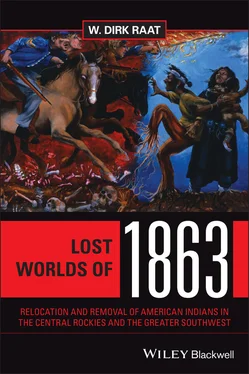A typical feature of this trade was that Indian girls as young as eight or nine were sold by their captors to other whites expressly as sexual partners. Sometimes they became concubines. Otherwise they would be used until they became useless. In December 1861, according to historian James Rawls, the Maryland Appeal “commented that, while kidnapped Indian children were seized as servants, the young women were made to serve both the ‘purposes of labor and of lust.’” In 1862 a correspondent to the Sacramento Union wrote about the “baby killers” of Humboldt County who “talk of the operation of cutting to pieces an Indian squaw in their indiscriminate raids for babies as ‘like slicing old cheese.’ …The baby hunters sneak up to a rancheria, kill the bucks, pick out the best looking squaws, ravish them, and make off with their young ones.” 55Boys as young as 12 were also enslaved, and given the disparity in power between master and slave, the conjecture is that pedophilia may have been a likely result.
In spite of the protestations of the Anglo-Americans of California, relations between Indians and whites in the Southwest paralleled those between blacks and whites in the Confederate South. Although California did not create slave codes like those in New Mexico, their laws and rules restricting Indian freedoms were similar to the infamous Black Codes of the South. Indian passes and the practice of limiting Indian mobility were similar to restrictions on blacks in the post-war South. Vagrancy and bail-out provisions were similar, as were instances where Indians and blacks could not testify against their white masters. 56While the Spanish and Mexican heritage of peonage and involuntary servitude was important for slavery in California, the racism, sexism, and violence that accompanied Indian slavery after 1850 became commonplace throughout much of the Indian Southwest.
In the early period prior to 1850, California Indians provided a variety of tasks for their white overlords, from laboring as mechanics and domestics to deckhands and lumbermen. The gold-rush of the late 1840s meant that most laborers were headed for the gold fields, and therefore the scarcity of labor for the remaining jobs required the use of Indian workers. And the Argonauts needed food for them and fodder for their livestock. Beef was in great demand. The California cattle boom extended the Mexican tradition of utilizing Indian labor on the ranchos and haciendas. In the 1850s most of the cattle ranches in Bernardino and Los Angeles counties used Indian laborers who were permanently attached to the soil, who were, as one contemporary observed, “no better than slaves.” Eventually, the “great drought” of 1862–1864 brought an end to the cattle industry, with many “useless” Indians becoming homeless vagabonds. 57
Of course, the dominant activity in the early years after the 1848 discovery of gold was not ranching but mining. The Hispanic tradition of the repartimiento or allocation was transferred from the farms to the mines, with the white miner and his Indian worker having a relationship not unlike the traditional ranchero and his Indian peon. One Argonaut estimated that within months after the initial discovery of gold, four thousand Indians worked alongside two thousand whites. Just as the Indians on the ranchos were considered as stock, so too were those who worked in the mines. And those whites, like Johann Sutter in Sacramento, who already controlled a body of Indian laborers before the 1848 strike, had an advantage over the newcomers in working the placer mines. The outsiders were naturally jealous of the old-timers. 58
After the initial discoveries Indian laborers began to disappear from the mines. This disappearance coincided with the arrival of the newcomers who had no prior experience with the Hispanic history of Indian exploitation. For them the Indian was useless since most Indians in their experience had been hostile and a threat to their security. In March 1849, three years after Frémont’s volunteers had decimated the Klamath Indian village in south-central Oregon, and one and a half years after the Whitman massacre left 13 dead missionaries in Walla Walla, Washington, 7 Oregon prospectors raped several Maidu women on a ranchería near the American River. This led to retaliation by Indian men and an escalation of violence in which Indians from the village of Colima were killed, arrested, and executed. It was no accident that the Colima site had been the place where Sutter had positioned his mill, and Sutter, of course, had generated much of the outsider’s anger and jealousy. After news of this incident spread, Indians in the mines fled from the whites fearing for the safety of themselves and their families. The jealousy of the newcomers had ignited an era of mutual fear and outrage, and a decade of Indian wars. 59
This is the California context in which John C. Frémont’s activities and ideas can be judged. First, it must be noted that in the late 1840s, prior to the discovery of gold, Frémont was essentially a tourist and newcomer. His behavior toward the Indian was not any more sophisticated than that of his fellow Oregonians who fought, killed, and raped Indians. Had he stayed only an explorer, his reputation as “the great pathfinder” would have been secure, but his decision to purchase the Mariposa estate transformed the surveyor into an unsuccessful entrepreneur.
The 43,000-acre estate, in the Sierra foothills only 40 miles southwest of Yosemite, had been the favorite hunting ground of the Cauchile Indians. Similar to other white rancheros, his land had been carved out of previous indigenous properties. Like his neighbors, he surrounded himself with de facto Indians slaves that worked his fields, and after the discovery of gold and silver on the Mariposas River, his Sonoran managers administered the Indian mineworkers. One of the prospectors was a black servant named Saunders, whose family was still in slavery, who was working the Mariposa mines for the purpose of working off his purchase price of $1,700. 60Generally speaking, while Frémont was generally consistent in his “free soil” views and his opposition to African chattel slavery in the South, he, like many of his contemporaries in the West, had a blind eye when it came to the issue of Indian slavery.
Jessie (Benton) Frémont was equally involved with the institution of Indian slavery. Throughout the 1850s and 1860s the most constant demand for Indian labor was that of Indian servants—male or female, young and old. In her Monterey house a Mexican chef oversaw Indian men who did most of the cooking, aided by Indian boys who hunted for food and assisted in the preparation of meals. Jessie noticed a remarkable similarity between the average California household and the “life of our Southern people.” In California it was typical for ladies of the house to be “surrounded by domesticated Indian girls at their sewing.” At Mariposa, Mission Indians were obtained by the Frémonts and required to work at laundering and other domestic chores. Jessie bragged about “playing Missionary” to a group of local Indians, plaiting their hair, and dressing them in starched calico and clean white undergarments. She was able to civilize these dirty people and transform them into “picturesque peasants.” 61
For Jessie to play missionary was in character, as she had always wanted to experience the man’s world, from her teenage days as a tomboy, through her vicarious experiences of her husband’s explorations and adventures (as described in her writings of her husband’s exploits), to her playing the role of Spanish missionaries domesticating and Christianizing their Indian subjects. Her maternalism was the counterpart to the paternalism that fostered Indian servitude, and she was as consistent in her “free soil” views as she was inconsistent on the subject of slavery. In this way she was her husband’s wife.
Читать дальше












